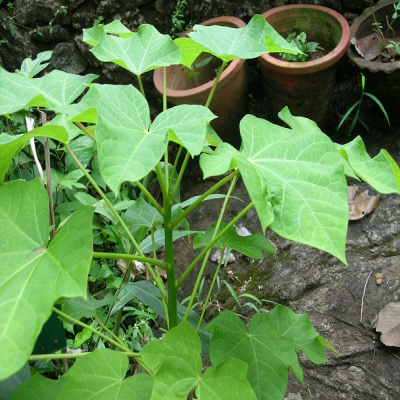Distribution and Habitat: It is grown in various parts of India as a field barrier.
Botany: A large deciduous soft wooded shrub or small tree, juice sticky opalescent.
- Leaves: Alternate, broadly ovate, cordate, acute, usually palmately 3 or 5 lobed, glabrous, base 7-nerved; petiole 7.5-23cm long.
- Flowers: Yellowish green in loose axillary cymose panicles. Male flowers many with 10 stamens, 5 united at the base only, 5 united in to a column. Female flowers borne singly with elliptic three celled tri ovulate ovary with three spreading bifurcated stigma.
- Fruits: 2.5cm long, ovoid, black, and breaking up in to three 2-valved cocci; seeds ovoid-oblong, dull brownish black. Seed resembles castor seed in shape but are smaller in size and of dark brown colour.
Properties: It is a purgative, galactagogue, rubefacient, suppurative and insecticide. Drugs are bitter, acrid, astringent, anthelmintic.
Chemical constituents:. Leaves contain Apigenin, Curcosones, lathyrane diterpenes, vitexin, isovitexin, stigmasterol and stigmastenes along with two new flavonoid glycosides found in leaves and twigs.
Uses: It is useful in dropsy, foul ulcers, sores, rheumatism, tumours, jaundices, stomach-ache, anaemia, biliousness, fistula, diseases of heart and skin and scabies.
Agrotechnology:
Soil and climate: It is well adapted to arid land semiarid conditions. It has low fertility and moisture demand and can come up stony, gravelly or shallow and even calcareous soils. It does not thrive in wet land conditions.
Propagation: by seeds or cuttings. The overnight soaking of seeds in water improves seed germination percentage. The rooted semi hard wood and hard wood cuttings also may be used for planting. The seeds or cuttings are directly planted in the main field with the onset of monsoon during June- August months.
Manures and Fertilizers: Although Jatropha is adapted to low fertility site and alkaline soils, better yield is obtained on poor quality soils if fertilizers with small amounts of calcium, magnesium and sulphur are used. Micorrhizal associations have been observed with Jatropha and are known to aid the plants growth under conditions where phosphate is limiting. In general application of super phosphate @ 150 kg/ha and alternated with one dose of 40:100:40 kg/ha NPK at 6 monthly intervals improves the yield. The application may coincide with rainy season or ensure proper irrigation immediately after application of fertilizers. From 4th year onwards 10% extra super phosphate should be added to the above dose.
Irrigation: During the dry period, the crop is irrigated 7-15 days interval depending on the requirement. Though the weekly irrigation is preferable, fortnight interval is compulsory. Drip irrigation is not ideal as it induces too much of vegetative growth.
Plant protection: Bark eater and pod borer are the major pests. They can be controlled with herbal pesticides such as mixtures of vitex, neem, aloe, Calotropis or rogor @ 2ml/lit. of water.
Collar rot may be the problem in the beginning and can be controlled with 0.2% COC.
Harvesting: The seeds are harvested as needed for medicinal purpose. For oil purpose the seeds are harvested when the fruits are turning yellow. The pods are collected manually and seeds are separated mechanically or manually. The seeds are to be dried in sun for four days (6-10% moisture level) before packing.
Processing: The dried seeds contain 66% kernel, which can yield between 46-58% oil. The extraction process standardized for edible oil is followed for extraction of Jatropha oil also. The oil is extracted by solvent extraction or mechanically by hydraulic or screw press.
Using a well-established procedure, manufacturers can mix the oil with methanol in a particular proportion at a specific temperature and separate the glycerol content, stirring continuously for two hours. Washing twice the residual solution yields purified bio-diesel. The production unit comprises, a vessel with heater, a stirrer assembly, a container for methanol and oil and few setting tanks to separate glycerol and washing tank to purify the fuel.


